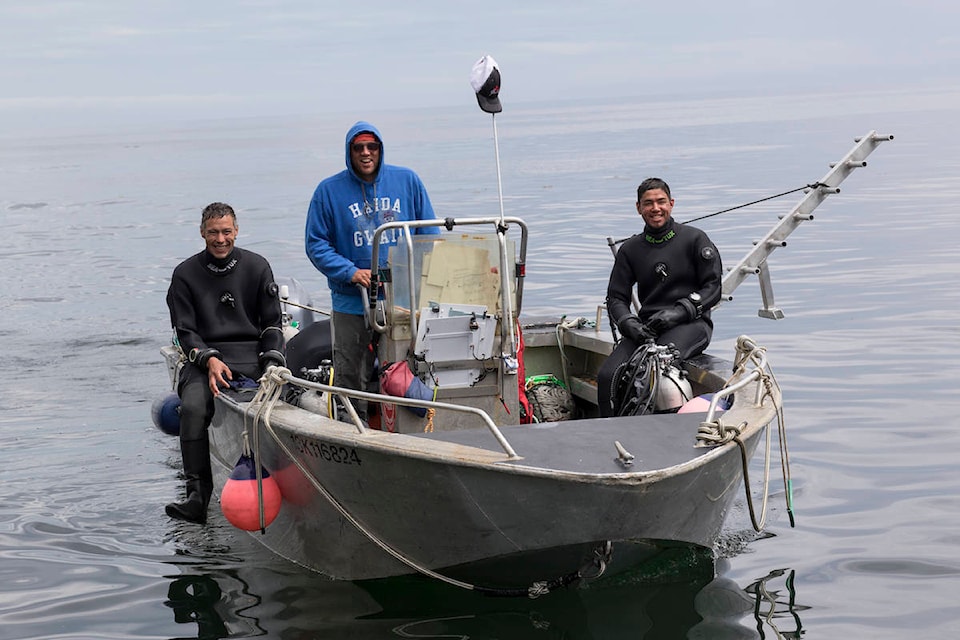by Shyanna Sawyer
This year a team of Haida, federal government, industry, and academic partners have transformed a stretch of urchin barrens to lush kelp forests, improving habitat for abalone and rockfish as they implement Gwaii Haanas’ newest ecosystem conservation and restoration project: Chiixuu Tll iinasdll: Nurturing Seafood to Grow.
Nearly 200 years ago, kuu (sea otters) disappeared from Gwaii Haanas as a result of the maritime fur trade. Ever since coastal ocean ecosystems in the area have experienced a cascade of change. Without kuu keeping populations in check, spiny guuding.ngaay (sea urchin) proliferated, and the cascade began. Guuding.ngaay began to graze down the rich kelp forests on which species like the endangered gaalgahlxyang (northern abalone) and many rockfish including the sGan (yelloweye), kaa (canary), sgan gwiidsxuldang (quillback) and bocaccio, depend on.
In many areas of Gwaii Haanas, the ocean floor is covered with guuding.ngaay and little else, reminiscent of a clear-cut forest, no longer able to support a diverse marine ecosystem. These places are called “urchin barrens.” Guuding.ngaay are a native species to the Gwaii Haanas ocean environment but they are so numerous they are considered “hyper-abundant”.
Since 2017 the Gwaii Haanas team and many partners have collaborated to study and implement the restoration of a three kilometre section of kelp forest in Gwaii Haanas. “Collaboration and sharing of expertise and resources are keys to success of the kelp restoration project,” says Lynn Lee, Parks Canada Marine Ecologist and one of the team leaders of Chiixuu Tll iinasdll. “Collaborators include Gwaii Haanas management partners (Council of the Haida Nation, Parks Canada Agency, Fisheries and Oceans Canada) as well as Haida Fisheries Program, Pacific Urchin Harvesters Association, Hakai Institute/Tula Foundation, Florida State University, University of Oregon, University of British Columbia, and University of New Brunswick.”
| Haida Fisheries Program Manager Vanessa Bellis checks out kelp regrowth alongside a school of rockfish. (Ryan Miller photo) |
The Chiixuu Tll iinasdll project reduced the density of guuding.ngaay by over 75 percent in a 20 hectare area of lower intertidal and shallow sub-tidal seafloor. Haida Fisheries divers were also provided training from scientific divers from the Hakai Institute. Since the training, the Haida fisheries divers can now independently and competently conduct kelp forest and rocky reef community surveys for fishes, invertebrates, and kelps because of this training. In the years following, the Gwaii Haanas team is aiming to work with fishing partners to maintain low guuding.ngaay numbers, allowing kelp forests to recover even more than they already have.
Before restoration work, kelp was only in a narrow shallow area right at the low tide level and no more than ten stems of kelp were counted on the shallowest restoration monitoring sites. Now, some of the shallowest transects have hundreds of kelp plants. The Pacific Urchin Harvesters Association (PUHA) were also involved by doing targeted fishing at the site and providing marketable urchins for guuding.ngaay community distribution this past spring.
According to PUHA President Mike Featherstone, “PUHA and the Haida Fisheries Program have a long relationship working together to undertake surveys and research. Going back to the 1980s, areas have been set aside from the commercial fishing to conduct these important collaborative ventures. It would not possible to get the outcomes we have without this collaborative work. This includes planning, funding, vessels, divers, developing joint goals and so on.”
Last summer while working with Gwaii Haanas I wrote an article focusing on why kelp forests were crucial to the underwater ecosystem and what Gwaii Haanas was doing to help these underwater understories grow. This summer I witnessed firsthand the difference between an urchin barren and a lush kelp forest and it nearly brought me to tears. In July, I travelled to Gwaii Haanas alongside some colleagues and three journalists. As the I watched the journalists swam amongst baby rock fish and examine the creatures just below the surface, I saw a swath of healthy growing kelp forests for three kilometers, over 20 soccer fields, around Gaysiigas Gwaay (Murchison Island) all because these ocean plants were given a chance to flourish. It truly gave me a perspective on just how important these underwater forests are for fish and humans alike. Kelp forests act as nurseries, habitat and an abundant feeding grounds for species of fish and seafood that people eat.
Ongoing urchin control and kelp forest research and recovery monitoring in the area will continue for at least the next three years. By monitoring the results of Chiixuu Tll iinasdll, we can all understand exactly how kelp restoration the land, sea and people of Haida Gwaii and how to conserve and restore kelp forests in the future.
